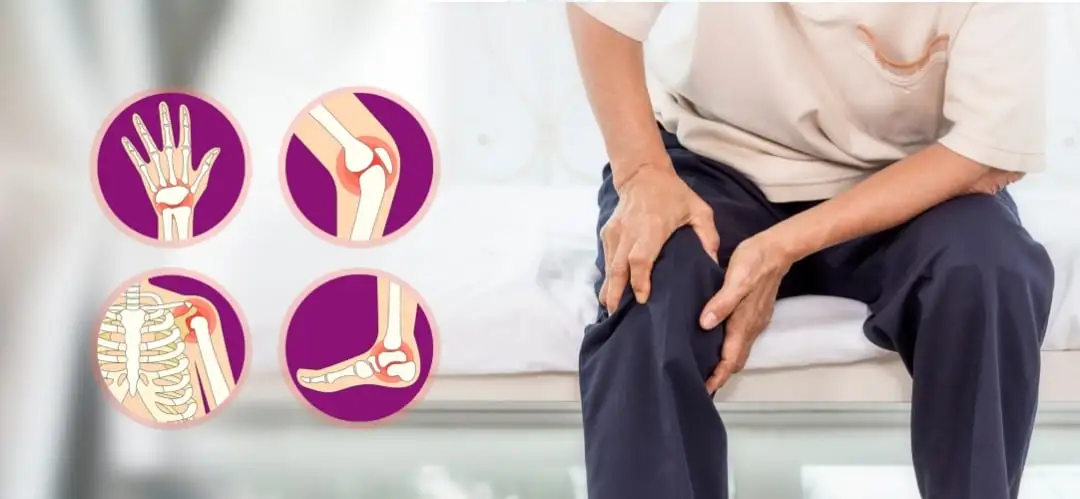Discover the essential guide to understanding arthritis, including inflammatory, osteoarthritis, connective tissue disease, infectious arthritis, and gout. Learn about causes, symptoms, and innovative treatments to alleviate pain and enhance your quality of life.

Introduction
Arthritis, a term that encompasses over a hundred different conditions, is characterized by joint pain and inflammation, affecting millions worldwide. This article delves into the major types, such as inflammatory, osteoarthritis, connective tissue disease, infectious arthritis, and gout, providing a detailed overview of their causes, symptoms, and the latest treatment options. Whether you’re seeking to understand your own symptoms or looking for effective management strategies, this guide offers valuable insights into navigating the complexities of arthritis.
Table of Contents
Arthritis Types: Causes and Symptoms
Arthritis encompasses a diverse group of conditions characterized by joint pain and inflammation. Each of them has distinct causes and symptoms, necessitating tailored approaches for diagnosis and management. Below is a professional and comprehensive overview of the major types, focusing on their specific causes and symptoms.
Inflammatory Arthritis
Causes
Inflammatory arthritis involves an autoimmune response where the immune system attacks the body’s own tissues, leading to inflammation in the joints and, occasionally, other organs. Genetic factors may predispose individuals to environmental triggers that initiate this autoimmune response.
Symptoms
This category includes persistent joint pain, stiffness (especially in the morning or after periods of inactivity), swelling, and redness. Systemic symptoms may include fatigue, fever, and loss of appetite. Chronic inflammation can lead to joint damage and deformity if not adequately treated.

Treatment Options
Medications:
- Disease-Modifying Antirheumatic Drugs (DMARDs): Slow disease progression and prevent joint damage. Examples include methotrexate, sulfasalazine, and leflunomide.
- Biologic Response Modifiers: Target specific pathways in the immune system to control inflammation. Examples include TNF inhibitors (e.g., etanercept, adalimumab) and IL-6 inhibitors (e.g., tocilizumab).
- Nonsteroidal Anti-Inflammatory Drugs (NSAIDs): Relieve pain and reduce inflammation.
- Corticosteroids: Quickly reduce inflammation and pain, used for short-term relief or to control flare-ups.
Physical Therapy:
Tailored exercises to maintain joint flexibility and muscle strength, and advice on protecting joints.
Surgery:
In severe cases, surgical options like synovectomy, joint replacement, or joint fusion may be considered to restore joint function or relieve pain.
Osteoarthritis (Degenerative or Mechanical Arthritis)
Causes
Osteoarthritis, the most common form of arthritis, results from the breakdown of cartilage that cushions the ends of bones in the joints. Age, joint injury, obesity, and genetics are significant risk factors. Over time, the wear and tear on cartilage can lead to bone grinding directly on bone, causing pain and restricted movement.
Symptoms
Symptoms include joint pain and soreness, stiffness, decreased flexibility, a grating sensation during joint movement, and the formation of bone spurs around the affected joint. Osteoarthritis can occur in any joint but commonly affects the hands, knees, hips, and spine.

Treatment Options
Medications:
- Acetaminophen: For pain relief.
- NSAIDs: For pain and inflammation. Topical NSAIDs can be applied directly to the affected joints.
- Corticosteroid Injections: Provide temporary pain relief by reducing inflammation.
Physical Therapy: Exercises to strengthen the muscles around the joint, improve flexibility, and reduce pain.
Weight Management: Reducing weight to lessen joint stress, particularly on weight-bearing joints like the hips and knees.
Assistive Devices: Braces, canes, or shoe inserts to improve joint function and reduce pain.
Surgery: Joint replacement surgery (arthroplasty) for severely damaged joints.
Connective Tissue Disease (CTD)
Causes
Connective tissue diseases are a group of disorders that affect the proteins providing support and structure to the body. They are caused by the immune system attacking the body’s own tissues, though the exact triggers are often unknown. Genetic factors are believed to play a role in predisposing individuals to these conditions.
Symptoms
Joint pain and inflammation are common symptoms, accompanied by various other symptoms depending on the specific condition, such as skin rashes in lupus or dry eyes and mouth in Sjogren’s syndrome. CTDs can also affect internal organs, leading to a wide range of systemic symptoms.

Treatment Options
Medications:
- NSAIDs and Corticosteroids: To reduce inflammation.
- DMARDs and Biologics: For systemic involvement and to target the immune system’s role in the disease.
- Antimalarial Drugs: Such as hydroxychloroquine, particularly for lupus.
Physical Therapy: To maintain mobility and function.
Specialist Consultations: Management may require a multidisciplinary approach involving rheumatologists, dermatologists, and other specialists depending on organ involvement.
Infectious Arthritis
Causes
Infectious or septic arthritis, occurs when a joint becomes infected by bacteria, viruses, or fungi. The infection can spread to the joint through the bloodstream from another part of the body or directly through a penetrating injury or surgical procedure.
Symptoms
The condition typically presents with acute and severe joint pain, swelling, redness, and warmth, often accompanied by fever and chills. It usually affects one joint, and prompt treatment is crucial to prevent joint damage.

Treatment Options
Antibiotics or Antifungal Medications: Immediate treatment with appropriate antimicrobials to clear the infection. The choice of medication depends on the type of microorganism causing the infection.
Joint Drainage: Removing infected fluid from the joint, either with a needle or through surgical drainage, to relieve pressure and pain.
Metabolic Arthritis (Gout)
Causes
Gout is caused by the deposition of uric acid crystals in the joint, resulting from high levels of uric acid in the blood. Factors contributing to elevated uric acid levels include diet (especially consumption of meat and seafood, which are high in purines), obesity, certain medications, and kidney problems that reduce the elimination of uric acid.
Symptoms
Gout is characterized by sudden, intense attacks of joint pain, swelling, redness, and tenderness, often affecting the big toe. The pain can be excruciating, with attacks occurring suddenly, typically at night.

Treatment Options
Medications:
- Nonsteroidal Anti-Inflammatory Drugs (NSAIDs): For acute attacks.
- Colchicine: Reduces gout pain, particularly effective when taken early in an attack.
- Corticosteroids: For those who cannot take NSAIDs or colchicine.
- Urate-Lowering Therapy: Medications like allopurinol and febuxostat reduce uric acid levels in the blood to prevent future attacks.
Lifestyle Changes: Dietary modifications to avoid foods high in purines, weight loss, and reducing alcohol intake.
Physical Therapy: To maintain joint function and relieve pain.
Nutritional Strategies and Supplements for Arthritis Management
Nutritional Impact on Arthritis
Diet plays a crucial role in managing arthritis symptoms. The foods you eat can either exacerbate or alleviate inflammation, which is a key factor in arthritis pain and progression. Adopting a balanced diet can help manage inflammation, improve joint health, and enhance overall well-being.
Anti-inflammatory Foods
Incorporating anti-inflammatory foods into your diet can significantly reduce it’s symptoms. Some of the most beneficial foods include:
- Fatty Fish: Rich in omega-3 fatty acids, such as salmon, mackerel, and sardines, known to reduce inflammation.
- Leafy Green Vegetables: Spinach, kale, and collards are high in antioxidants and vitamins that can combat inflammation.
- Nuts and Seeds: Almonds, walnuts, flaxseeds, and chia seeds are excellent sources of healthy fats and nutrients that support joint health.
- Berries and Fruits: Strawberries, blueberries, cherries, and oranges contain antioxidants that help reduce inflammation.
These foods work by reducing inflammation in the body, which can decrease pain and improve mobility.
Foods to Avoid
Certain foods can trigger inflammation and worsen symptoms, including:
- Processed Foods: High in unhealthy fats and sugars that can increase inflammation.
- Sugary Foods and Beverages: Can lead to weight gain and higher inflammation levels.
- Certain Fats: Saturated and trans fats found in red meat and processed foods should be limited.
Avoiding these foods can help manage arthritis symptoms and improve overall health.
Supplements for Arthritis
Several supplements may offer additional benefits:
- Fish Oil: Contains omega-3 fatty acids that can reduce joint inflammation.
- Glucosamine and Chondroitin: Often used together to help reduce pain and improve joint function.
- Curcumin: The active component in turmeric, known for its potent anti-inflammatory properties.
It’s important to consult with a healthcare provider for the appropriate dosage and to ensure these supplements are safe for you.
Healthy Eating Plans
Adopting a diet plan that emphasizes anti-inflammatory foods can support joint health. The Mediterranean diet is highly recommended for individuals with arthritis. It focuses on:
- Fruits and Vegetables: A variety of colorful produce provides antioxidants and nutrients.
- Whole Grains: Sources of fiber and nutrients that support overall health.
- Healthy Fats: Olive oil and nuts, which are central to the Mediterranean diet, offer healthy fats that can reduce inflammation.
Incorporating these foods into your daily meals can promote joint health.
Consultation with Healthcare Providers
Before making significant dietary changes or starting new supplements, it’s crucial to consult with healthcare professionals. They can provide personalized advice based on your health condition, medication, and specific needs, ensuring that your diet and supplements safely support your arthritis management plan.
Adopting these nutritional strategies and considering supplements can play a significant role in managing it. Alongside medical treatments and physical therapy, a well-planned diet can help reduce pain, improve mobility, and enhance the quality of life.
FAQ Section
Q: What are the main types of arthritis?
A: The main types include inflammatory arthritis, osteoarthritis, connective tissue disease, infectious arthritis, and gout, each with unique causes and symptoms.
Q: How is it diagnosed?
A: Diagnosis typically involves a combination of physical exams, medical history evaluation, and diagnostic tests such as blood tests, X-rays, and MRIs to determine the type and severity.
Q: Can it be cured?
A: While there is no cure for most types of arthritis, many treatments can help manage symptoms, reduce pain, and improve quality of life.
Q: Are there lifestyle changes that can help manage these?
A: Yes, lifestyle changes such as maintaining a healthy weight, engaging in regular physical activity, eating a balanced diet, and avoiding excessive strain on joints can significantly help manage symptoms.
Conclusion
Understanding the various types of arthritis and their respective causes and symptoms is the first step toward effective management and treatment. With advancements in medical science, there are now more options than ever to help lead a pain-reduced and active life. It’s crucial to consult healthcare professionals to tailor a treatment plan that best suits your condition and lifestyle, ensuring you can navigate arthritis with confidence and support.









